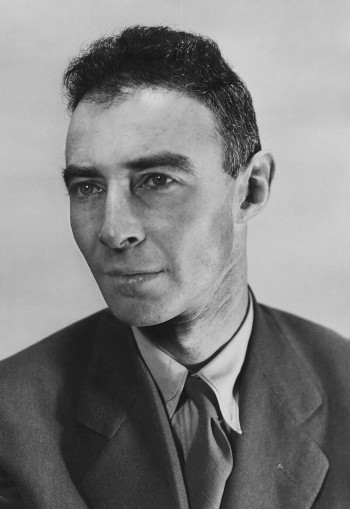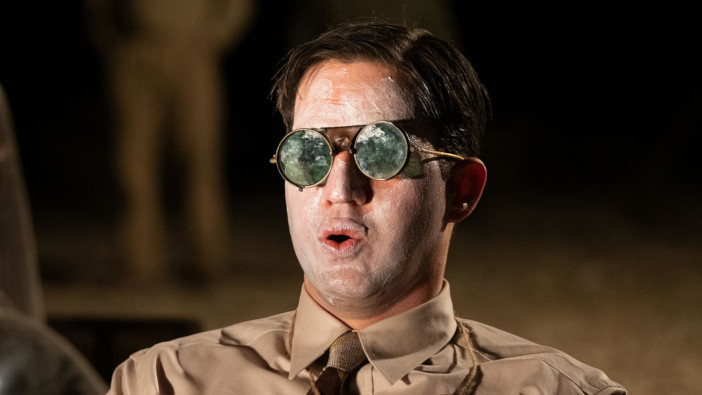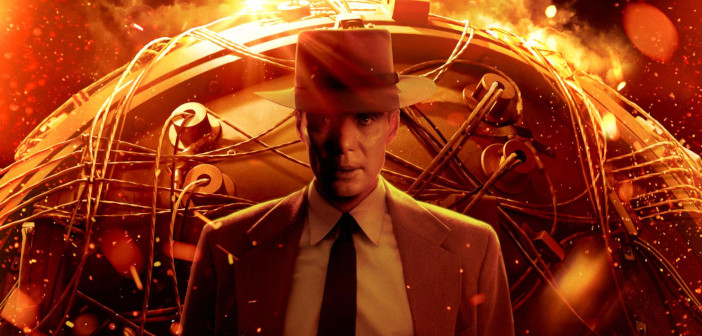Struggling manfully to reach minute sixty of Christopher Nolan’s “Oppenheimer”, as someone with the sensation of wading waist-deep in a vast sump of used engine oil, the image of a large wounded animal thrashing about in a maze while attempting to reach the exit came to mind; with the animal doubling for a workable screenplay, the maze as the world moving from volcanic hot war to a polar freezing one, and the maze’s exit being a narrative which would somehow reach a workable dramatic conclusion. But before I continue, I have to declare first that I have a more than strong interest in Oppenheimer’s near tragic story, as I have currently a show of over 30 of my paintings of WW2 and its aftermath at Bentley Priory Museum in North London. Quite a few of these are images of the devastation caused by his brainchild, which many feel should have been aborted at birth. Secondly, and more to the point, I’d like to share a few facts with you which may affect your reaction to this overblown filmic experience, just as they did for me, although they barely rate a mention in Nolan’s version of events.
Two months before the first bomb (nicknamed Gadget) was tested, the scientists and military decided to hold a rehearsal of the upcoming event. On May 7th 1945 they detonated 100 tons of TNT spiked with plutonium, and as the scientists had last- minute concerns about the possibility of the test creating dangerous levels of radioactivity, they set up some hastily conceived tests. Doctors from the Manhattan Project used primitive battery clips to position live rats at points close to the pile of explosives. This last-minute badly executed “after thought”, in the words of a report, prepared beyond the event, “was poorly designed and executed, yielding no results; the rats closest to the blast were simply incinerated totally, whilst those further off were blown free of their wires and never recovered.”

Cillian Murphy as J. Robert Oppenheimer. Photo courtesy of Universal Studios (c) 2023.
Preparations for the first atomic test were woefully inadequate. The fact of radioactive contamination was not considered a serious issue and people were living as close as 12 miles from the centre of the blast. And the weather conditions at the time were simply atrocious. As the storm raged in the hours before the first test, Italian physicist Enrico Fermi warned Oppenheimer, “there could be catastrophe.” Oppenheimer took a break from reading the poetry of Baudelaire to relay to the military his version of the warning: “The weather is whimsical.” The decision was made to proceed with the test. When Gadget exploded it brought heat of a kind never before experienced on the surface of the Earth from a man-made intervention. The shockwave broke windows 180 miles away in Silver City. Eighty percent of the bomb’s plutonium core failed to fission, making it a truly “dirty bomb” by today’s standards. Dangerous levels of radioactive fallout spread across New Mexico and far beyond. A few days later, a thousand miles away, the fallout ruined a batch of Eastman Kodak film at their factory in Indiana. Half a century later, cancerous deaths as a result of the blast were still being recorded.
Now to the film itself. The first “act” is a confusing conflation of fact, speculation and snippets of re-enacted civil and military hearings; hearings in which Oppenheimer stands accused, time and again it seemed, of basically un-American activity, if not the outright leaking of secrets to the Soviet Union. Perhaps this was Nolan’s attempt to cram as many facts into this preamble before the more serious and dramatic business of the build-up to the first actual testing of the bomb. If so, the results continually hover between proper dramatic realisation and black and white documentary-style footage. Here I fully sympathise with Nolan’s dilemma, that being the complications in Oppenheimer’s life and especially his career, with official doubts about his suitability for almost every job he was proposed for. But this constant moving from colour to black and white presumably to indicate present, future and past respectively, became more confusing than clarifying. In short, a distracting melange with the audience, at least as I suspect, waiting for the true drama of the manufacture and testing of the bomb to commence.

The real Oppenheimer, 1944.
When at last it did, this central section of the film is handled much more effectively by Nolan, but for me there is a problem with the film as a whole and what has been triumphed as its very lynch-pin, that of Cillian Murphy’s performance as Oppenheimer. Now, I have watched countless documentaries picking at the literal wounds caused by this dreadful bomb, including those let loose on its progenitor. But I learnt more in a few seconds of watching and listening to the real Oppenheimer, with those flickering eyes and with his soft, distinct, and unrepeatable accent, in grainy 16mm footage, than three hours in the company of CM. He is undoubtedly a fine actor, as we saw manifestly in Peaky Blinders, but what he gives us here is a simulacrum of the man, not the real man. Surely that would be true whoever stepped into the role? Possibly, but another actor might bring a greater degree of world-weariness, of the weight of experience of life bearing down on him, to such a complex role. And this is precisely what CM falls short of giving us: the potential nuances as he moves from public to private life, and back again. His face reflects blankness at almost every stage whereas the real-life 16mm Oppenheimer did not. In those few real documentary flashes, we see that very complexity, internal struggle and vulnerability simultaneously. Is Cillian’s performance true Oscar material? Clearly it is as he won! But for me at least it left a substantial hole at the centre of a film charting the public destruction of an intensely private man. A man in this version we hardly get to know at all.
However, there is an almost equally serious omission, again at the film’s core, and here I am tempted to call it a double helix, and that is the complete failure even to attempt to explain the workings of this astonishing bomb. Unlike “The Double Helix”, the film charting the unwinding of DNA sequencing, which did a pretty good job of telling us, the uninitiated, what DNA was actually about, Oppenheimer tells us little or nothing about nuclear fission. All we see is a clumsy arrangement of metal eighths or quarters being assembled in the form of a large Rubik’s Cube, with absolutely no mention of what the pieces either together, or separately, represent. Please indulge me for a moment while I quote the following, from The Nuclear Secrecy blog: “one of the key parts of the implosion design for the atomic bomb (the same sort of bomb detonated at Trinity and over Nagasaki) is the neutron initiator that sits at the absolute centre of the device. It is a deceptively tricky little contraption. At the instance of maximum compression, it needs to send out a small burst of neutrons, to get the whole chain reaction started. It’s not even that many neutrons, objectively speaking — in the order of a hundred or so in the first bombs. But conjuring up a hundred neutrons, at the centre of an imploding nuclear assembly, at just the right moment, was a tricky technical problem, apparently. The details are still classified.” I am betting you know more now about the bomb’s still secret inner workings than almost all who have sat for hours in the darkness, watching Nolan’s sketchy interpretation of what they were all really up to in The Los Alamos National Laboratory.

I am conscious when bringing a critical view to bear on a film which has been lauded and praised to the skies and brought people in droves back to real cinema, that this must be some kind of perversity for someone with great admiration of Nolan and for what he has brought to the Art of Film itself. But regrettably for me there are other elements which contribute to my rating of this as a two star film, three short of the “five star General.” Oppenheimer’s mistress who killed herself and was a key player when Oppenheimer was flirting with Communism, barely appears in the film. Emily Blunt as Oppenheimer’s wife simply has to do more than deliver one withering glance to one of her husband’s traitors to justify her presence, but Nolan renders her a cypher, a mere appendage. And then for me the greatest mistake of all, to leave the story of this ultimate weapon just at the moment that it is about to change history forever: no, not the first test but the first application, its use to wreak destruction on Hiroshima and its innocent occupants, and shortly thereafter, that of Nagasaki.
But there are Thespian delights to be had within the film’s cumbersome presentation, especially that of Oscar-winning Robert Downley Jr as the duplicitous Chairman of the Atomic Energy Commission, all smiles and snake oil who simply commands the screen whenever he appears. And there is one key and great scene, immaculately presented, where Oppenheimer meets the President who unleashed the bomb, Harry S. Truman. Here it is Gary Oldman who gives us an astonishing cameo, and when presented with Oppenheimer’s comment that he feels he has blood on his hands, offers him his handkerchief, and sends him out of the White House with a dismissive, “don’t ever let that cry baby in here again.”
In conclusion it seems to me that the film is simply overwhelmed by its literally earth-shattering subject matter, too big to be recreated by mere actors and even brilliant technicians. Also I feel duty bound to point out that the “hook” to which Nolan returns during the drama several times, a brief meeting initially seen from afar between Oppenheimer and Albert Einstein, is an unnecessary contrivance. This I assume was a somewhat clumsy nod to the wonderfully prophetic play by Michael Frayn, “Copenhagen”, where a piece of scientific discovery is deliberately withheld, thus denying the Nazi’s the necessary technology to develop their own nuclear weapon.
Please allow me a final shot. Whilst I applaud Nolan’s dogged devotion to film, that is the real celluloid that runs through cameras at 24 frames a second, I do not share the received opinion that the cinematography in “Oppenheimer” is of a quality somewhere beyond outstanding. I have just watched the whole of the new series of “Ripley” right though, in pretty much two binge sessions, and this immaculate photography, using an Arri Digital Camera, strikes me as being much more inventive. Come to think of it, if “Oppenheimer” had arrived in a complete black and white “Ripley” style presentation, I think quite a few of my reservations may have been answered, and we might even have been able to nail another couple of stars back onto General Oppenheimer’s insignia.
Oppenheimer is currently available to watch on Sky Premiere. Photos courtesy of Universal Studios (c) 2023.




